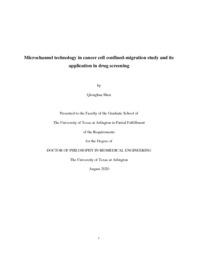| dc.description.abstract | PDMS-based microchannel device has been explored to extend the basic platform for three-dimensional (3D) culture models of cell motility study because of its relevant stiffness and designable shape. Moreover, it is easy to add multi-functions (physical cures and biochemical cures) to one single device and provide a more physiologically relevant context to cells migrating inside channels. As recent cell motility studies have proved that cells show different migration strategies in physiologically confined three-dimensional (3D) space compared to a two-dimensional (2D) culture system. Besides, far from unique, when cancer cells are underling the migrating stage, they show increased resistance to chemo- and radio-therapies compared to non-migrating cells. Therefore, it is consequential to understand the invasion mechanism of migratory cancer cells (for example, GBMs) and explore the insight link between metastasis under physical confinement and acquired therapeutic resistance, in order to devise efficient therapeutic strategies. To choose/ design suitable tools for confined migration study is the fundamental step. In the past four years, I have been focusing on using microchannel platforms to study cancer cell’s confined-migration behavior and its correlation with metastatic cancer’s therapeutic resistance. Above this, I also try to design a suitable microchannel platform to combine cell motility study with a high-throughput screening method to address issues from cancer tissue’s heterogeneity. I have published one article in a peer-reviewed journal and had two manuscripts in the submission that are related to this. All the above-mentioned works are summarized in the following chapters.
Chapter 1: Shen, Q., Hill, T., Cai, X., … & Kim, Y.T. (2020) Physical Confinement during Cancer Cell Migration Triggers Therapeutic Resistance and Cancer Stem Cell-like Behavior.
Chapter 2: Shen, Q., Germain, A., & Kim, Y.T. (2020) Migration and Physical Confinement are Two Indispensable Elements for Upregulating GBM’s Chemotherapeutic Resistance.
Chapter 3: Shen, Q., Niederstrasser, H., Barakat, R., … & Kim, Y. T. (2020). Single-cell-level screening method for migratory cancer cells and its potential feasibility in high-throughput manner. Biofabrication, 12(3), 035019. | |


